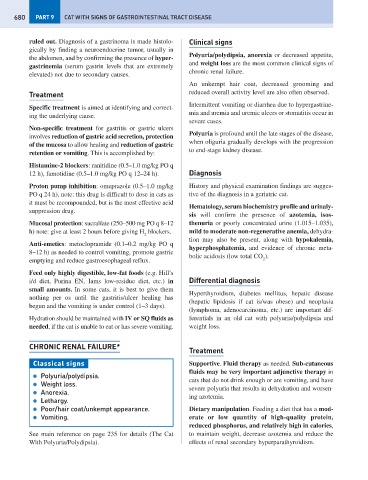Page 688 - Problem-Based Feline Medicine
P. 688
680 PART 9 CAT WITH SIGNS OF GASTROINTESTINAL TRACT DISEASE
ruled out. Diagnosis of a gastrinoma is made histolo- Clinical signs
gically by finding a neuroendocrine tumor, usually in
Polyuria/polydipsia, anorexia or decreased appetite,
the abdomen, and by confirming the presence of hyper-
and weight loss are the most common clinical signs of
gastrinemia (serum gastrin levels that are extremely
chronic renal failure.
elevated) not due to secondary causes.
An unkempt hair coat, decreased grooming and
Treatment reduced overall activity level are also often observed.
Intermittent vomiting or diarrhea due to hypergastrine-
Specific treatment is aimed at identifying and correct-
mia and uremia and uremic ulcers or stomatitis occur in
ing the underlying cause.
severe cases.
Non-specific treatment for gastritis or gastric ulcers
Polyuria is profound until the late stages of the disease,
involves reduction of gastric acid secretion, protection
when oliguria gradually develops with the progression
of the mucosa to allow healing and reduction of gastric
to end-stage kidney disease.
retention or vomiting. This is accomplished by:
Histamine-2 blockers: ranitidine (0.5–1.0 mg/kg PO q
12 h), famotidine (0.5–1.0 mg/kg PO q 12–24 h). Diagnosis
Proton pump inhibition: omeprazole (0.5–1.0 mg/kg History and physical examination findings are sugges-
PO q 24 h), note: this drug is difficult to dose in cats as tive of the diagnosis in a geriatric cat.
it must be recompounded, but is the most effective acid
Hematology, serum biochemistry profile and urinaly-
suppression drug.
sis will confirm the presence of azotemia, isos-
Mucosal protection: sucralfate (250–500 mg PO q 8–12 thenuria or poorly concentrated urine (1.015–1.035),
h) note: give at least 2 hours before giving H blockers. mild to moderate non-regenerative anemia, dehydra-
2
tion may also be present, along with hypokalemia,
Anti-emetics: metoclopramide (0.1–0.2 mg/kg PO q
hyperphosphatemia, and evidence of chronic meta-
8–12 h) as needed to control vomiting, promote gastric
bolic acidosis (low total CO ).
emptying and reduce gastroesophageal reflux. 2
Feed only highly digestible, low-fat foods (e.g. Hill’s
i/d diet, Purina EN, Iams low-residue diet, etc.) in Differential diagnosis
small amounts. In some cats, it is best to give them
Hyperthyroidism, diabetes mellitus, hepatic disease
nothing per os until the gastritis/ulcer healing has
(hepatic lipidosis if cat is/was obese) and neoplasia
begun and the vomiting is under control (1–3 days).
(lymphoma, adenocarcinoma, etc.) are important dif-
Hydration should be maintained with IV or SQ fluids as ferentials in an old cat with polyuria/polydipsia and
needed, if the cat is unable to eat or has severe vomiting. weight loss.
CHRONIC RENAL FAILURE*
Treatment
Classical signs Supportive. Fluid therapy as needed. Sub-cutaneous
fluids may be very important adjunctive therapy in
● Polyuria/polydipsia.
cats that do not drink enough or are vomiting, and have
● Weight loss.
severe polyuria that results in dehydration and worsen-
● Anorexia.
ing azotemia.
● Lethargy.
● Poor/hair coat/unkempt appearance. Dietary manipulation. Feeding a diet that has a mod-
● Vomiting. erate or low quantity of high-quality protein,
reduced phosphorus, and relatively high in calories,
See main reference on page 235 for details (The Cat to maintain weight, decrease azotemia and reduce the
With Polyuria/Polydipsia). effects of renal secondary hyperparathyroidism.

